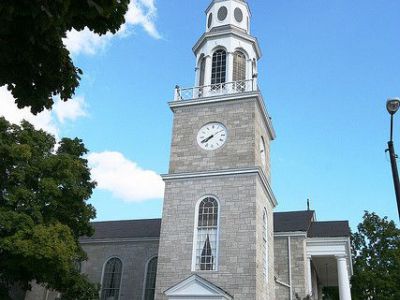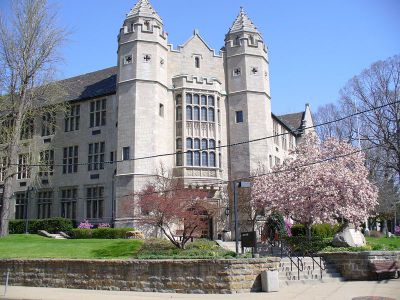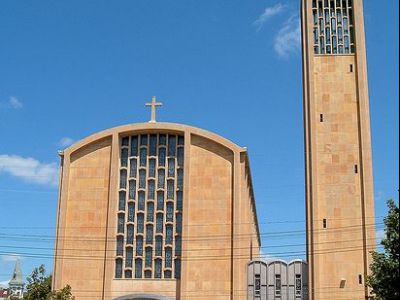
Youngstown Introduction Walking Tour (Self Guided), Youngstown
As a part of the U.S. “Rust Belt” region, Youngstown suffered major decline in the 1970s. Today, despite that decline, the city offers an array of cultural and recreational facilities owing to which in 2012 it was declared by Forbes the 4th best city in Ohio for raising a family. The range of local attractions has grown in recent years, seeing among the newest additions the Covelli Centre in the downtown area, a number of sport venues and more. Follow this orientation walk to discover some of the best attractions Youngstown has to offer.
How it works: Download the app "GPSmyCity: Walks in 1K+ Cities" from Apple App Store or Google Play Store to your mobile phone or tablet. The app turns your mobile device into a personal tour guide and its built-in GPS navigation functions guide you from one tour stop to next. The app works offline, so no data plan is needed when traveling abroad.
Youngstown Introduction Walking Tour Map






Guide Name: Youngstown Introduction Walking Tour
Guide Location: USA » Youngstown (See other walking tours in Youngstown)
Guide Type: Self-guided Walking Tour (Sightseeing)
# of Attractions: 13
Tour Duration: 3 Hour(s)
Travel Distance: 4.6 Km or 2.9 Miles
Author: AudreyB
Sight(s) Featured in This Guide:
Guide Location: USA » Youngstown (See other walking tours in Youngstown)
Guide Type: Self-guided Walking Tour (Sightseeing)
# of Attractions: 13
Tour Duration: 3 Hour(s)
Travel Distance: 4.6 Km or 2.9 Miles
Author: AudreyB
Sight(s) Featured in This Guide:
- Downtown Youngstown
- Realty Building
- Metropolitan Bank Tower
- First Presbyterian Church
- Jones Hall
- McDonough Museum of Art
- Butler Institute of American Art
- St. Columba Cathedral
- Youngstown Historical Center of Industry and Labor
- Powers Auditorium
- Hungarian Presbyterian Church
- Fellows Riverside Gardens
- Mill Creek Park
1) Downtown Youngstown
Downtown Youngstown is the traditional center of the city of Youngstown, Ohio, United States. After decades of precipitous decline, the downtown area shows signs of renewal. Civic leaders have expressed hope that the district will emerge as a significant arts and entertainment district within the Youngstown-Warren metropolitan area.
Downtown Youngstown is the site of most of the city's government buildings and banks. A number of entertainment venues are also located in the downtown, including the Covelli Centre, Powers Auditorium (the original Warner Bros. Theatre), the DeYor Performing Arts Center, Oakland Centers for the Performing Arts and The “Man on the Monument”. The “Man on the Monument” is a familiar landmark to those of us who live in the area. In addition, the downtown sits to the immediate south of notable cultural and educational resources, including Youngstown State University, the Butler Institute of American Art, and the McDonough Museum of Contemporary Art.
Downtown Youngstown is the site of most of the city's government buildings and banks. A number of entertainment venues are also located in the downtown, including the Covelli Centre, Powers Auditorium (the original Warner Bros. Theatre), the DeYor Performing Arts Center, Oakland Centers for the Performing Arts and The “Man on the Monument”. The “Man on the Monument” is a familiar landmark to those of us who live in the area. In addition, the downtown sits to the immediate south of notable cultural and educational resources, including Youngstown State University, the Butler Institute of American Art, and the McDonough Museum of Contemporary Art.
Sight description based on Wikipedia.
2) Realty Building
The Realty Building, constructed in 1924 as home to the Realty Guarantee and Trust Company, is a Neoclassical Revival high-rise designed by Morris Schiebel and Edgar Stanley. This twelve-story building is a significant example of Youngstown’s unique collection of architecture.
3) Metropolitan Bank Tower
The Metropolitan Bank Tower, another wonderful design of architect Morris Scheibel, is a 224 foot 18 floor building, and Youngstown’s tallest structure since 1929. Designed in the Art Deco style for the Central Savings and Loan Company, it features an Egyptian-inspired entrance, a lavish Art Deco lobby and other beautiful elements of the style. In 1976 the building was purchased by Metropolitan Savings and Loan and was renamed. Subsequently purchased by First National Bank, nowadays it is also known by this name.
4) First Presbyterian Church
Founded in 1799, the First Presbyterian Church of Youngstown is the oldest church in the Western Reserve. The present sanctuary was dedicated in 1960, featuring classic Georgian Epoque elements. An impressive architecture with four immense columns and three grand doorways, the First Presbyterian Church is one of the most prominent religious buildings in Youngstown.
5) Jones Hall (must see)
Jones Hall, constructed in 1931 in the Gothic Collegiate style, is Youngstown State University’s oldest building. Named in honor of Dr. Howard Jones, the college’s first president, nowadays Jones Hall houses the university’s administration and is known to be one of the most photographed buildings in the city.
6) McDonough Museum of Art
The McDonough Museum of Art is a center for contemporary art located on the campus of Youngstown State University (YSU).
Opened in 1991 in a building designed by Gwathmey Siegel & Associates Architects, the museum focuses on contemporary art through exhibits and art education. The origins of the museum begin in 1986 through the donations and efforts of local physician and art collector John J. McDonough, who used proceeds from the sale of his painting Gloucester Harbor by Childe Hassam to fund construction.
The museum features changing exhibitions, installations, performances, and lectures by regional, national and international artists, and also functions as public outreach for the YSU College of Fine and Performing Arts and the Department of Art, exhibiting work by students, faculty and alumni. In addition the museum offers free lectures, performances, and programs organized in collaboration with various departments at the university and the Youngstown community at large.
Opened in 1991 in a building designed by Gwathmey Siegel & Associates Architects, the museum focuses on contemporary art through exhibits and art education. The origins of the museum begin in 1986 through the donations and efforts of local physician and art collector John J. McDonough, who used proceeds from the sale of his painting Gloucester Harbor by Childe Hassam to fund construction.
The museum features changing exhibitions, installations, performances, and lectures by regional, national and international artists, and also functions as public outreach for the YSU College of Fine and Performing Arts and the Department of Art, exhibiting work by students, faculty and alumni. In addition the museum offers free lectures, performances, and programs organized in collaboration with various departments at the university and the Youngstown community at large.
Sight description based on Wikipedia.
7) Butler Institute of American Art (must see)
The Butler Institute of American Art was the first museum dedicated exclusively to American art.
Established by local industrialist and philanthropist Joseph G. Butler, Jr., the museum has been operating pro bono since 1919. Dedicated in 1919, the original structure is a McKim, Mead and White architectural masterpiece listed on the National Register of Historic Places.
Additional highlights include an iconic depiction of George Washington's wedding, William Gropper's celebrated Youngstown Strike, an interpretation of the area's violent 1937 Little Steel Strike, and Albert Bierstadt's 'Oregon Trail, 1869.
In recent years, the Butler has expanded significantly. A 19,000-square-foot (1,800 m2) south wing, the Beecher Center, was constructed in conjunction with Youngstown State University in 2000 with a focus of uniting technology and art. Two years later, the 3,400-square-foot (320 m2) Andrews Pavilion, featuring a sculpture atrium, gift shop, and café, was added to the rear of the facility. In 2006, the Butler purchased the neighboring First Christian Church facility and converted it into an education and performing arts center.
Established by local industrialist and philanthropist Joseph G. Butler, Jr., the museum has been operating pro bono since 1919. Dedicated in 1919, the original structure is a McKim, Mead and White architectural masterpiece listed on the National Register of Historic Places.
Additional highlights include an iconic depiction of George Washington's wedding, William Gropper's celebrated Youngstown Strike, an interpretation of the area's violent 1937 Little Steel Strike, and Albert Bierstadt's 'Oregon Trail, 1869.
In recent years, the Butler has expanded significantly. A 19,000-square-foot (1,800 m2) south wing, the Beecher Center, was constructed in conjunction with Youngstown State University in 2000 with a focus of uniting technology and art. Two years later, the 3,400-square-foot (320 m2) Andrews Pavilion, featuring a sculpture atrium, gift shop, and café, was added to the rear of the facility. In 2006, the Butler purchased the neighboring First Christian Church facility and converted it into an education and performing arts center.
Sight description based on Wikipedia.
8) St. Columba Cathedral
Saint Columba Cathedral is a Catholic cathedral.
The first Mass celebrated in Youngstown occurred in 1826. Saint Columba Parish was founded in 1847.
The first church was completed in 1853 and the parish school was opened in 1860. As the parish grew a larger church was needed. The second church building was completed in 1868.
The parish continued to grow and yet another church was built and it opened in 1897. The second church building was torn down in 1940.
Saint Columba’s was named the new diocese’s cathedral. The cathedral was destroyed in a fire. The new cathedral was completed in 1958 and it became the parish’s fourth church building.
The first Mass celebrated in Youngstown occurred in 1826. Saint Columba Parish was founded in 1847.
The first church was completed in 1853 and the parish school was opened in 1860. As the parish grew a larger church was needed. The second church building was completed in 1868.
The parish continued to grow and yet another church was built and it opened in 1897. The second church building was torn down in 1940.
Saint Columba’s was named the new diocese’s cathedral. The cathedral was destroyed in a fire. The new cathedral was completed in 1958 and it became the parish’s fourth church building.
Sight description based on Wikipedia.
9) Youngstown Historical Center of Industry and Labor (must see)
The Youngstown Historical Center of Industry and Labor, located in Youngstown, Ohio, preserves the history of the steel industry that dominated the Youngstown area's economic life for much of the 20th century.
The museum is operated by the Ohio Historical Society. The facility, which was designed by noted architect Michael Graves, is reminiscent of a steel mill, complete with stylized smoke stacks.
A groundbreaking ceremony was held in 1986. The center opened with temporary exhibits in 1990, and established a permanent collection in 1992.
The center's permanent exhibit, titled "By the Sweat of Their Brow: Forging the Steel Valley," examines the community's industrial past using video, photographs, artifacts, and reconstructed scenes.
The museum is operated by the Ohio Historical Society. The facility, which was designed by noted architect Michael Graves, is reminiscent of a steel mill, complete with stylized smoke stacks.
A groundbreaking ceremony was held in 1986. The center opened with temporary exhibits in 1990, and established a permanent collection in 1992.
The center's permanent exhibit, titled "By the Sweat of Their Brow: Forging the Steel Valley," examines the community's industrial past using video, photographs, artifacts, and reconstructed scenes.
Sight description based on Wikipedia.
10) Powers Auditorium
Powers Auditorium is the largest auditorium in the Youngstown-Warren area. The facility is the main venue of downtown Youngstown's DeYor Performing Arts Center.
The complex also includes the Adler Art Academy, Beecher Flad Pavilion, and Ford Family Recital Hall. Originally built in 1931 as the Warner Theatre, the former movie palace was renovated and reopened as Powers Auditorium in 1969.
The main tenant of Powers Auditorium is the Youngstown Symphony, which performs from October through May. The facility also hosts other musical acts, touring Broadway productions, and locally produced theater (primarily from Ballet Western Reserve and Easy Street Productions, two Youngstown-based theater companies).
The complex also includes the Adler Art Academy, Beecher Flad Pavilion, and Ford Family Recital Hall. Originally built in 1931 as the Warner Theatre, the former movie palace was renovated and reopened as Powers Auditorium in 1969.
The main tenant of Powers Auditorium is the Youngstown Symphony, which performs from October through May. The facility also hosts other musical acts, touring Broadway productions, and locally produced theater (primarily from Ballet Western Reserve and Easy Street Productions, two Youngstown-based theater companies).
Sight description based on Wikipedia.
11) Hungarian Presbyterian Church
As with several other Youngstown churches, the Hungarian Presbyterian Church is a beautiful reminder of the city’s multicultural influence. A work of fine masonry, its facade was designed to resemble a medieval tower. This unique church remains a significant addition to Youngstown’s array of splendid landmarks.
12) Fellows Riverside Gardens
Fellows Riverside Gardens (11 acres) are public botanical gardens included in the Mill Creek Metro Parks system. The gardens are located at 123 McKinley Avenue, in Youngstown, Ohio, United States. They are open daily with no admission fee.
In 1958, Mrs. Elizabeth A. Fellows bequeathed the property to Mill Creek Park, together with funds to create a public garden on the site. The first plantings began in 1963.
In 1958, Mrs. Elizabeth A. Fellows bequeathed the property to Mill Creek Park, together with funds to create a public garden on the site. The first plantings began in 1963.
Sight description based on Wikipedia.
13) Mill Creek Park (must see)
Mill Creek Park is the second largest metropolitan park in the United States after Fairmount Park in Philadelphia, and the 140th largest park located within the limits of a U.S. City.
The park was founded in 1891 due to the "untiring efforts of Youngstown attorney Volney Rogers".
Mill Creek Park now stretches from the near west side of Youngstown to the southern borders of the city and neighboring Boardman township. The park "encompasses approximately 2,600 acres (10.5 km²), 20 mi (32 km) of drives, and 15 mi (24 km) of foot trails" as well as a variety of bridges, ponds, streams, well-tended gardens, and waterfalls.
The park was founded in 1891 due to the "untiring efforts of Youngstown attorney Volney Rogers".
Mill Creek Park now stretches from the near west side of Youngstown to the southern borders of the city and neighboring Boardman township. The park "encompasses approximately 2,600 acres (10.5 km²), 20 mi (32 km) of drives, and 15 mi (24 km) of foot trails" as well as a variety of bridges, ponds, streams, well-tended gardens, and waterfalls.
Sight description based on Wikipedia.
The Most Popular Cities
/ view all












